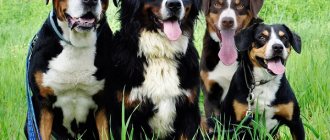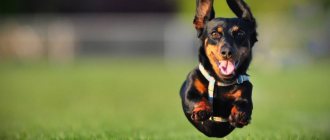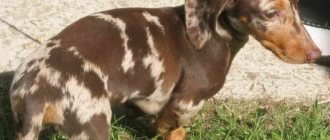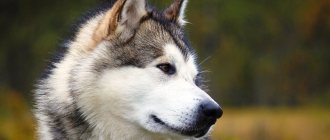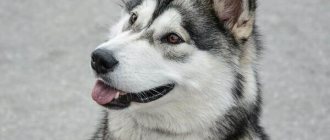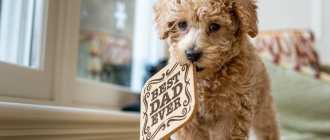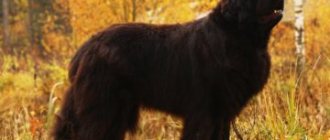I have been keeping dachshunds for 25 years, so the characteristics of the breed will be biased. I love these sausages with all my heart. And not just me. More than a million dachshunds now live in Germany alone. At the same time, their popularity is stable, it does not depend on fluctuations in fashion - but how many breeds can boast of the same?
The dachshund is unique. Its small size and ease of care make it a popular companion for city dwellers. At the same time, one cannot dare to call the breed decorative; dachshunds remain “real”, serious dogs.
Longhaired dachshund
It is difficult to explain why dachshund owners become so attached to their pets. I have personally seen how stern men turn into pink jelly when they look at their dogs. The dachshund may be considered a misunderstood dog, but in fact, almost everyone likes their sly faces.
But I have also seen refuseniks. Their owners stated that the dog made their lives hell. Therefore, I will not enthusiastically squeal “the dachshunds are perfect, only two dachshunds are better” (although this is exactly what I usually do). I will try to give a complete description of the breed - with all the advantages and disadvantages.
Author of the article: Olga Shiltsova, practicing veterinarian, author of the books “Dachshund of Fate” and “Tails of Fortune”
Is the dachshund in your case a conscious choice or an accident?
In our case, the dachshund is an absolutely conscious choice, but at the same time a compromise.
My previous dachshund had a back problem and wanted my next dog to be free of potential back problems. In addition, I wanted a service breed dog - a Doberman. But my wife said that the Doberman is too big, and we will take a dachshund. And I said that then we’ll take it not by volume, but by quantity, and we took two dachshunds.
It was a smart choice and overall I'm pleased. And I don’t regret that I don’t have a Doberman.
What are the pros and cons of dachshunds?
First of all, I am satisfied with love for a person, closeness to a person, and sometimes even the feeling of being one with a dog.
As for the disadvantages, the dachshund can sometimes be too stubborn, and it is extremely difficult to convince him. And there are times when unquestioning instant submission is required, and here potential conflicts can arise.
But in general, I think that this is a very good breed: on the one hand, the dog is small due to short legs, and on the other hand, if you imagine a dachshund on normal legs, it turns out to be quite a medium-sized dog.
In addition, I love smooth-haired dogs because in our climate they are quite easy to care for.
Breed characteristics
The pet is quite independent, but loves to communicate with its owner, gets along well with other pets, and does not require long, tedious brushing of its fur (the breed is short-haired). The dachshund has a distinctive appearance: there are no varieties of dogs that resemble this short pet with an elongated body, long ears, a sharp muzzle and a thin, elastic tail.
Dachshund breed standards:
| Parameter | Peculiarities |
| Appearance | Long body, short, strong legs, fairly long thin tail, sharp muzzle, floppy, long ears, dark eyes, feet slightly turned outward |
| Weight | Miniature dachshund – up to 5 kg, standard – from 7 to 15 kg |
| Height | No more than 35 cm |
| Lifespan | Up to 15 years in good conditions |
| Color | Red – the most popular. Other types of color: black, dark background with tan or apples, chocolate, cream |
| Height at withers | From 30 to 35 cm |
| Coat types | Wire-haired, smooth-haired, long-haired |
Do you have standard rates?
Yes, I have two “standards”, and at the upper limit of the size: they weigh 11 kg each.
From experience: But at the same time they are in shape, constantly on the move. We walk them three times a day, for a long time, a total of 4 - 4.5 hours on weekdays and 5 - 6 hours on weekends. In winter, when it's cold, the walks are shorter, but instead of three times a day, we can go out 6-7 times to keep the dogs on the move more. If the frost is below -15 degrees, we put sweaters on the dogs. And even at home they are constantly moving: chasing each other, spinning, fighting.
Plus proper, good feeding without excesses, because the main thing is not to overfeed the dachshund.
The result is good dogs: active, sometimes uncontrollable (because they are dachshunds), but at the same time giving a huge amount of positive energy.
Are dachshunds brave dogs?
Very! In my opinion, they are brave to the point of recklessness. Dachshunds do not feel like small dogs; they are able to attack a large dog absolutely fearlessly. Our dachshunds together attacked a Ridgeback, a Staff, a Husky - they are not afraid of anyone. At the same time, they assess the situation in their own way and make their own decisions. First of all, they are guided by their head, and secondly by the commands of the owner.
From experience: Unfortunately, our dachshunds are pugnacious. I don’t like pugnacious dogs and I believe that a dog in the city does not need to fight - it is better to resolve all issues peacefully. But our dogs grew up together, feel like a pack and are guided, rather, by some kind of common intelligence. When they meet another dog, they try to take it out of fear, and if it is “led”, they attack for real. This does not depend on the size of the enemy.
If the other dog is not scared, they sniff and lose interest.
Pembroke Welsh Corgi
Description
The Welsh Corgi, despite its small height, not exceeding 30 cm, is a shepherd dog.
Bred in Wales in the early Middle Ages, these dogs were widespread throughout Britain as early as the 10th century AD. Their main purpose was to herd livestock.
According to one legend, Pembroke Welsh Corgis were given to people by fairies, who used them instead of draft animals.
Pembrokes have short straight legs, a highly elongated body, large erect ears and a fox-like muzzle. A characteristic feature of these dogs is the black edging of their lips, which gives the impression that the dog is smiling.
The coat is shiny and silky, reaching approximately the same length as a German Shepherd, the undercoat is short and water-resistant. The color can be red and white, tricolor or fawn, sometimes black. The tail is usually short by nature or docked.
Character
Pembrokes are friendly, active and affectionate dogs. They are good with other animals and children and love to play.
Peculiarities
Pembroke dogs are very smart dogs, occupying second place in the ranking of the smartest breeds in terms of intelligence.
Usually, they do not speak often, but when greeting the owner who has returned home, some Welsh Corgis perform a kind of “song”, which is a characteristic howl with modulations.
How curious are dachshunds?
Very curious! If you can stick your nose somewhere, a dachshund's nose will definitely be there. And if you don’t tear the dog away from some interesting place, it can sit with its nose buried in a hole for an hour.
On sunny weekends we go out to the islands in the area of Komsomolskaya Lake, where we can dig. And when the dogs start digging, I just sit down and wait - an hour, an hour and a half - and they keep digging... Dachshunds can do this for hours.
They can look at a fly outside the window for 5 - 10 minutes.
Character
The rabbit dachshund has a friendly character towards people; despite its excellent hunting instinct and fairly developed guard dog skills, the small pet creates a relaxed and cheerful atmosphere in the house. During the hunting off-season, the dog's tireless energy forces it to demonstrate various funny tricks and amuse its owners.
How well do your Dachshunds train?
Apparently, I'm not a very good dog handler. It was easier with the previous dogs because they had different characters. And I have questions with the dachshunds. It is clear that they understand, but do they want to obey?
The point is not to force them to obey, but to negotiate obedience. But there is very little information on the Internet, and the dog handlers I have encountered were not particularly impressed.
How good an appetite do dachshunds have?
Dachshunds, in my opinion, are one of the breeds that have the best appetite. But here it is important to understand that, in addition to a good appetite, a dachshund also has such gentle eyes, and when the dog below looks pitifully at you, it is very difficult not to give him a piece of a bun or sausage. However, it is mega important not to overfeed a dachshund - I say this as a person who had a dachshund with back problems precisely because of overeating. I think this is the main thing that can keep a dachshund healthy.
From experience: Our dogs eat dry food, and I know that a dog should eat 175 g of food per day. So each dachshund eats 175 g - and not a gram more. And I forbid pets from feeding dogs from the table.
To treat dogs on the street, I go to the store and buy special low-calorie treats that do not add weight to the dog.
Historical reference
Previously, the dachshund was bred strictly for hunting in holes, so in this direction it is considered the oldest breed. Despite the fact that images of dogs with external similarities were discovered even in excavations from the times of Ancient Egypt, the modern phenotype was formed in the Middle Ages (XVI century). It is believed that the animal's homeland is South Saxony.
Previously, dachshunds were taken to hunt badgers in holes.
The progenitors are German racing bracks, from which the short limbs were passed on. If among ancestors this feature was considered as a disadvantage, then among dachshunds it became indispensable for burrow hunting.
German farmers, who suffered from the activity of badgers destroying agricultural land, immediately drew attention to all the advantages of the new breed. In addition, it was also appreciated by city residents due to its ease of care and convenient maintenance in urban environments.
Towards the end of the 17th century. The dachshund has become popular not only in Germany, but also in other European countries. The number of individuals quickly increased, and the first nurseries were opened where purebred representatives were bred.
But since there was no uniform approach to the specifics of reproduction, breeders solved the problem by following their preferences. Therefore, 2 directions were formed - decorative and working.
In 1870, breeders established the first standard, which mentioned the main purpose of the dachshund - hunting. Ten years later, dog breeder von Bosch designed an artificial burrow for animal training, which is still used to this day in training working dogs.
According to the FCI classification, dachshunds belong to a separate category with wide variability - there are 9 officially recognized and standardized varieties.
The breed appeared on the territory of Russia in the 18th century, but then it was not very popular. Already in 1900, the first Russian Society of Fox Terrier and Dachshund Lovers was formed, after which the founders and participants of the association began to hold exhibitions and publish stud books.
The breed is very popular in Russia.
The dachshund gradually became even more popular, despite the fact that it was treated as a decorative breed. Against the backdrop of the bloody consequences of 2 world wars of the 20th century. the number of livestock declined sharply. During the exhibition event in 1958, only 11 individuals were shown.
As a result of many years of diligent work, the catastrophic problem was eliminated.
Today, dachshunds are considered to be the most common and sought-after breeds in the domestic space.
And we smoothly move on to the issue of the dachshund’s health...
If you feed your dachshund correctly, walk it a lot, vaccinate it on time and treat it against ticks, then there will be no health problems. Unless it's an accidental injury.
You can't just take a dog. We must understand that a dog is, of course, not a child, but something close to a child. You need to be aware of the responsibilities of owning a dog. The dog needs to be walked a lot, given attention, socialized, fed with the right foods (canine, not human). If you raise your dog correctly, there will be no problems.
Until a certain age, I carried dachshunds down the stairs. Now our dogs have grown up, they move a lot, they have a well-formed muscle corset, so I’m not afraid of problems with the spine.
What kind of owner do you think a dachshund needs?
Hard to tell. I am a rather harsh, hot-tempered person, sometimes I overreact, my wife is a calmer person, and my son always doesn’t care at all, that is, we have three different characters. At the same time, we all get along with dachshunds. Therefore, it seems to me that the dachshund is a universal dog. She is small, but not small, active, but in moderation.
If an inexperienced person decides to adopt a dachshund, he should have a good, understanding veterinarian in mind. It must be remembered that dachshunds can have problems with the spine, and sometimes there are problems with digestion. It is also advisable to contact a person who can help with training and establishing a relationship with the pet.
Photos of dachshunds from the personal archive of Dmitry Bolashev
«
Peppermint treat
Royal canin dog food: reviews and composition analysis
Ingredients:
- 1 medium overripe banana.
- 2 chicken eggs.
- 3 tbsp. spoons of honey.
- 3 tbsp. tablespoons of liquid coconut oil (can be replaced with sunflower oil in the same amount).
- 1/2 teaspoon mint flavoring.
- 1/2 teaspoon baking powder.
- A quarter cup of carob (roasted carob powder). A small amount of cocoa can be substituted, but this is not recommended for animals. Therefore, try to find an original product.
- Oat flour.
Cooking procedure.
1. Mash the banana in a bowl.
2. Beat eggs into the resulting mass, add honey, baking powder, cinnamon and coconut (sunflower) oil.
3. Add oatmeal to the mixture to form a firm but slightly moist dough.
4. Divide the resulting volume into 2 equal parts.
5. Pour 1/4 cup of carob powder into one half, and add the same amount of flour to the second half. A hard lump should form that does not stick to your hands.
6. Roll out 2 rectangles, 9-10 mm thick.
7. Place the layers of dough on top of each other and roll along the long side. Wrap the resulting sausage in plastic wrap and put it in the refrigerator overnight.
8. Preheat the oven to 180 degrees.
9. Cover a baking sheet with parchment paper.
10. Remove the film and cut into 3-3.5 cm rounds.
11. Place on a baking sheet. During cooking, portions of dough will not increase in volume, so you can place them close to each other.
12. Bake for 10-15 minutes.
If you want to please your pet with a crunchier treat, cut the rolls into thin slices (about 1 cm), and after cooking, additionally dry them in a warm oven or even in a non-stick frying pan.
The finished product is stored for a long time in a dry place. So, by baking peppermint rolls once, you can treat your four-legged pupil with them for a long time.
Bon appetit to your dog!
I like it I don't like it
